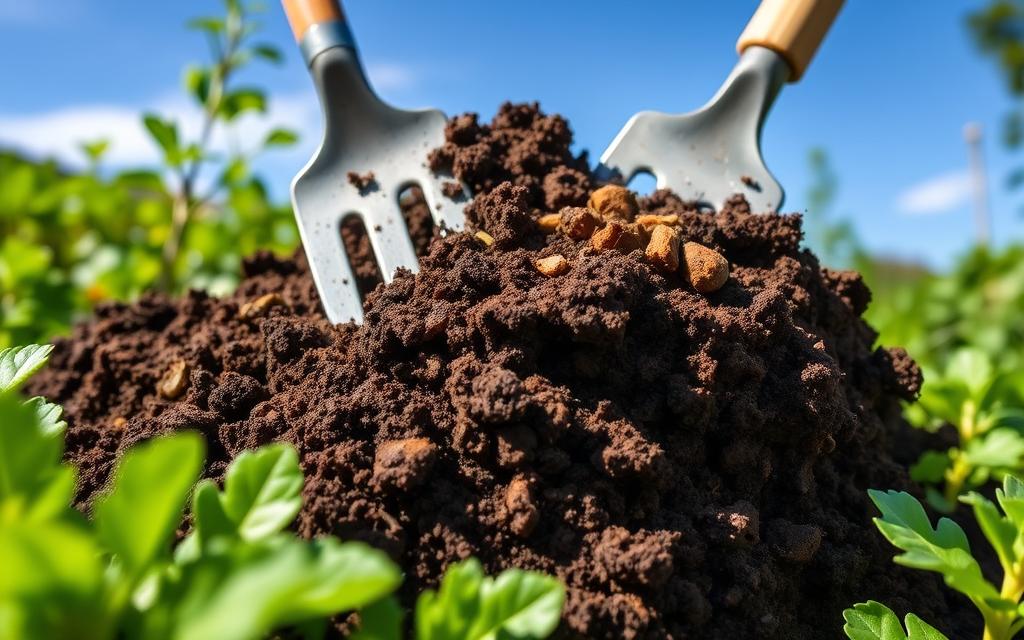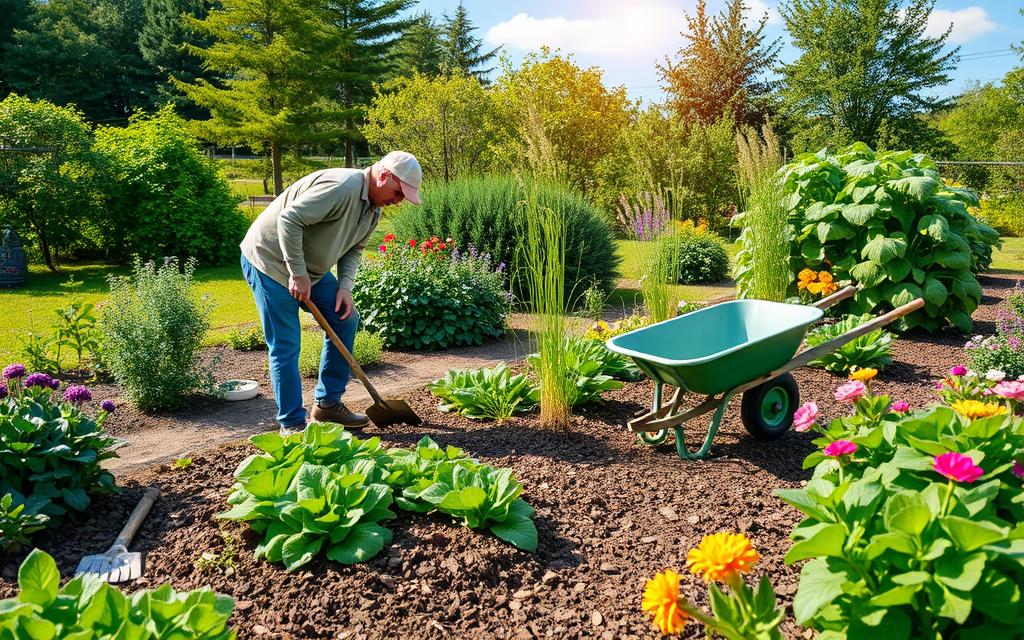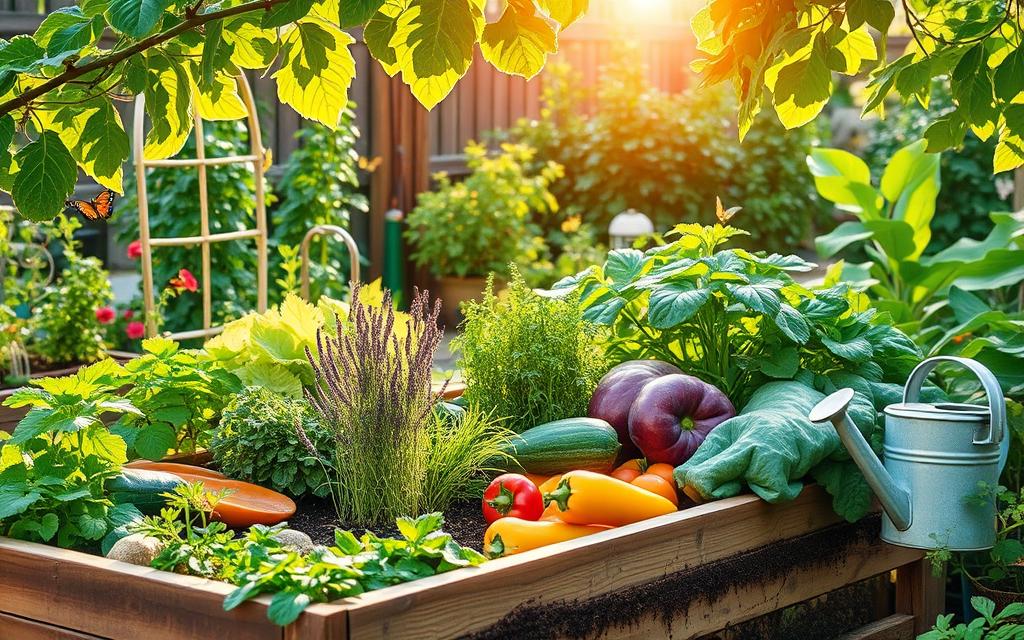Have you ever wondered if you can grow veggies without harmful chemicals?
Welcome to organic gardening tips for beginners! If you’re new, you’re in the right spot. Starting your organic garden might seem tough, but it’s easy and fun with the right tips.
In this article, we’ll cover organic gardening for beginners and share easy organic gardening tips to help you start. You’ll learn how to prepare your garden, choose the best tools and plants, and more. This will help you grow a healthy and green garden.

Disclaimer: This post contains affiliate links, which means I may earn a small commission if you purchase through these links at no extra cost. Thank you for supporting my blog!
- Why Choose Organic Gardening?
- Preparing Your Garden Space
- Essential Tools for Organic Gardening
- Picking the Right Plants for Your Region
- Starting Seeds Indoors
- Organic Soil Amendments and Fertilizers
- Natural Pest Control Methods
- Watering Strategies for an Organic Garden
- Companion Planting Techniques
- Frequently Asked Questions – FAQ
What You’ll Learn
- Start with a small, manageable garden space.
- Choose the right location with adequate sunlight.
- Ensure your soil is healthy and fertile.
- Invest in essential gardening tools.
- Select plants suited for your region and climate.
- Embrace natural pest control methods.
Quick Recommendation: 1,001 Gardening Tips & Tricks: Timeless Advice for Growing Vegetables, Flowers, Shrubs, and More
Why Choose Organic Gardening?
Switching to organic gardening is good for your health and the planet. It uses natural methods instead of harmful chemicals, which is better for both you and the environment.
Benefits for Your Health
Organic gardening is great for your health. You can grow your own food without harmful chemicals. This means you get fresh, healthy fruits and veggies without pesticides.
Environmental Advantages
Organic gardening is also good for the planet. It keeps the soil healthy, saves water, and supports many plants and animals. It also reduces the need for harmful chemicals, protecting our wildlife and ecosystems.

Cost-Effectiveness in the Long Run
Starting an organic garden might cost more at first. But it saves money in the long run. You won’t need to buy expensive chemicals or go to the store as much. Plus, you’ll be more self-sufficient and save on groceries.
Preparing Your Garden Space
Starting your garden right is key to a successful organic garden. Choose the best spot, prepare your soil well, and think about raised beds. These steps are essential for your garden’s success.
Choosing the Right Location
Finding the perfect spot for your garden is crucial. It should get 6-8 hours of sunlight a day. Make sure it drains well to avoid waterlogged soil.
Stay away from trees and big bushes. They compete for nutrients and water.
Soil Preparation and Testing
Soil preparation is vital for healthy plants. First, test your soil to know its pH and nutrient levels. This helps you make the soil better.
Add organic compost, mulch, and natural fertilizers. They improve soil structure and nutrient levels.

Building Raised Beds
Raised beds have many benefits. They improve drainage, control weeds, and help roots grow. You can easily manage the soil quality.
Raised beds warm up faster in spring. This extends your growing season. They also prevent soil compaction, which is good for roots.
| Aspect | Benefits |
|---|---|
| Improved Soil Drainage | Reduces waterlogging and root diseases |
| Better Weed Control | Easier to manage and weed |
| Enhanced Root Growth | Looser soil allows roots to expand |
| Extend Growing Season | Soil warms faster in raised beds |
| Minimized Soil Compaction | Prevents soil from becoming hard and compact |
Essential Tools for Organic Gardening
Starting an organic garden is rewarding, but you need the right tools. Knowing about organic gardening hand tools, irrigation for organic gardens, and mulching for beginners is key. These tools will help you enjoy and succeed in your gardening journey.
Personal Favorite: Gardening Tools 9-Piece Heavy Duty Gardening Hand Tools with Fashion and Durable Garden Tools Organizer Handbag, Rust-Proof Garden Tool Set, Ideal Gardening Gifts for Women.
Hand Tools
Good hand tools are essential for organic gardening. They help you work your garden efficiently and accurately. Here are some must-have tools:
- Hand Trowel: Great for moving young plants and digging small spots.
- Secateurs/Pruners: Essential for cutting and picking.
- Weeder: Removes weeds without harming the soil.
- Garden Fork: Important for mixing soil and compost.
Choosing durable, comfortable tools will make gardening easier and less tiring.
Watering Equipment
Right irrigation for organic gardens is crucial for plant health. You’ll need:
- Watering Can: Perfect for watering seedlings and young plants precisely.
- Hose with Adjustable Nozzle: Flexible for watering large areas.
- Soaker Hose: Waters plants evenly, saving water.
- Drip Irrigation System: Automated for consistent watering.
Mulching Materials
Mulching for beginners means using materials to keep soil moist, control weeds, and improve soil. Here are some good options:

| Material | Benefits | Usage Tips |
|---|---|---|
| Organic Straw | Keeps moisture in and weeds out. | Make sure it’s seed-free to avoid new plants. |
| Composted Leaves | Adds nutrients as it breaks down, improving soil. | Shredding leaves helps them decompose faster. |
| Grass Clippings | Helps keep soil moist and is easy to find. | Use thin layers to avoid matting. |
| Wood Chips | Lasts long and improves soil structure. | Apply 2-3 inches thick, avoiding plant stems. |
Related Article: Gardening for Beginners: Turn Gardening Into a Hobby
Picking the Right Plants for Your Region
Choosing the right plants for your garden is key in organic gardening. Opting for local plant varieties ensures they fit your climate and soil. This approach makes your garden healthy and supports local biodiversity.
“The key to successful gardening lies in understanding and working with your local environment,” says renowned horticulturist Monty Don.
To make your garden fit your region, follow these tips:
- Learn about your local climate and hardiness zone to pick the best plants.
- Use climate-specific gardening methods for your area, like smart watering and mulching.
- Check out local nurseries and gardens to find thriving local plant varieties.
- Talk to local gardening groups and extensions for tips on gardening in your area.
Also, making a chart or calendar for planting times can help plan your garden. Here’s an example:
| Season | Recommended Plants | Key Considerations |
|---|---|---|
| Spring | Spinach, Peas, Broccoli | Start seeds indoors, ensure soil is well-drained |
| Summer | Tomatoes, Peppers, Squash | Maximize sunlight exposure, moderate watering |
| Fall | Kale, Carrots, Beets | Use mulch to retain soil moisture, cover crops to protect from frost |
| Winter | Garlic, Onions, Perennial Herbs | Ensure adequate mulch coverage, focus on frost-tolerant varieties |
Focusing on climate-specific gardening and using local plant varieties will ensure a thriving organic garden throughout the year.
Quick Recommendation: Survival Vegetable Seeds Garden Kit Over 16,000 Seeds Non-GMO and Heirloom, Great For Emergency Bugout Survival Gear 35 Varieties Seeds For Planting Vegetables 35 FREE Plant Markers Gardeners Basics
Starting Seeds Indoors
Starting seeds indoors is a rewarding and efficient way to get a head start on your gardening season. This method allows you to control the germination process, ensuring your plants are strong and healthy when it’s time to transplant them outdoors. Let’s explore the key aspects of starting seeds indoors, from seed selection to transplanting seedlings.
Seed Selection
Selecting the right seeds is the first step in starting seeds indoors. Choose seeds that are suited to your climate and growing season. For germinating seeds organically, opt for organic and non-GMO seeds from reliable sources. Tomatoes, peppers, and herbs are great choices for beginners looking to start their indoor seed journey.
Indoor Growing Conditions
Creating the ideal environment for starting seeds indoors is crucial for their success. Utilize seedling trays and quality potting mix to support growth. Maintain a consistent temperature of around 70-75°F (21-24°C) and provide adequate light, ideally 12-16 hours per day, using grow lights if necessary. Properly water your seedlings to keep the soil moist but not waterlogged, ensuring the right conditions for germinating seeds organically.
Transplanting Seedlings
Once your seedlings have grown strong, it’s time to guide them to their new home. Begin by hardening off your seedlings, gradually exposing them to outdoor conditions over a week. Ensure the outdoor soil is prepared and at the right temperature before transplanting. Carefully transplant the seedlings to minimize root disturbance, giving them the attention they need to thrive. Effective seedling care during this stage will set the foundation for a robust and productive garden.
| Aspect | Benefits |
|---|---|
| Starting Seeds Indoors | Allows for early start; better control of conditions |
| Germinating Seeds Organically | Healthier plants; eco-friendly |
| Seedling Care | Encourages strong root development; prepares plants for transplanting |
Organic Soil Amendments and Fertilizers
Knowing about organic soil amendments and natural fertilizers is key to keeping your garden healthy and productive. Composting and using green manures are great ways to improve your soil naturally.
Composting
Composting is about turning kitchen scraps and yard waste into something valuable. It not only cuts down on waste but also gives plants the nutrients they need. To speed up the process, begin your compost pile with a mix of brown and green materials.
Using Green Manures
Green manures are plants grown to improve the soil in organic gardening. Legumes, for example, are great because they add nitrogen to the soil. When you plow them back in, you add nutrients and improve the soil’s health.
Organic Fertilizer Options
There are many natural fertilizers for different gardening needs. Here are a few:
- Bone Meal – Rich in phosphorus, great for root development.
- Blood Meal – High in nitrogen, supports leafy growth.
- Fish Emulsion – Balanced fertilizer, promotes overall plant health.
- Seaweed Extract – Provides trace minerals and promotes root development.
The secret to successful organic gardening is using the right natural fertilizers. This keeps the soil fertile and helps plants grow well.
Natural Pest Control Methods
Using organic pest management is crucial for a thriving garden. By attracting beneficial insects and making natural pest deterrents, you can keep your garden pest-free. This creates a harmonious environment for your plants.
Introducing Beneficial Insects
Attracting beneficial insects in gardens is a key strategy. Ladybugs, lacewings, and predatory beetles help control pests. Planting marigolds, daisies, and yarrow attracts these helpful insects.
Homemade Organic Pest Sprays
Making natural pest deterrents at home is easy. Mix garlic, chili peppers, and neem oil to create effective sprays. These sprays are safe, eco-friendly, and budget-friendly.
- Garlic Spray: Blend garlic cloves with water, strain, and add a few drops of dish soap.
- Chili Pepper Spray: Mix crushed chili peppers with water and a drop of dish soap.
- Neem Oil Spray: Combine neem oil with water following the manufacturer’s instructions.
Physical Barriers and Traps
Physical barriers and traps are essential for organic pest control. Row covers, netting, and traps keep pests away. For example, copper tape around raised beds deters slugs and snails, and yellow sticky traps catch flying insects.
| Method | Purpose | Application |
|---|---|---|
| Row Covers | Prevent insect damage | Place over plants; anchor edges |
| Copper Tape | Deters slugs and snails | Wrap around beds or pots |
| Sticky Traps | Catch flying insects | Hang near infested plants |
Using these natural methods helps keep your garden healthy and thriving. Whether you want to attract beneficial insects, make homemade sprays, or use physical barriers, these methods are effective.
Watering Strategies for an Organic Garden
Using the right watering methods is key to a thriving organic garden. It ensures plants get the right amount of moisture without wasting water. Let’s explore some effective ways to do this.
- Drip Irrigation: This method sends water straight to the roots through a network of tubes. It cuts down on evaporation and runoff, making sure water goes where it’s needed.
- Soaker Hoses: Soaker hoses slowly release water, giving plants a steady supply. This helps prevent overwatering and encourages deep root growth.
- Rainwater Harvesting: Collecting rain in barrels or cisterns is good for the planet. It saves water and gives plants soft, pH-balanced rainwater, perfect for their growth.
When to water is just as important. Watering in the early morning or late evening helps plants absorb water better. It also cuts down on evaporation.
- Check your irrigation system often for leaks.
- Change your watering schedule with the seasons and weather.
- Use mulch to keep soil moist and water less often.
Here’s a table comparing different watering methods and their benefits:
| Technique | Benefits |
|---|---|
| Drip Irrigation | Reduces evaporation, targets roots directly |
| Soaker Hoses | Even water distribution, prevents over-watering |
| Rainwater Harvesting | Conserves water, provides naturally balanced rainwater |
Choosing sustainable watering methods saves water and boosts your organic garden’s health and yield.
Companion Planting Techniques
Companion planting is a smart way to garden. It means planting different crops together for their mutual benefits. This method makes your garden healthier and more productive. A companion planting guide helps you pick the best plant neighbors.
Planting for Mutual Benefits
Companion planting has many advantages. Some plants improve soil, keep pests away, or provide shade. For example, basil near tomatoes can keep aphids off and help tomatoes grow better. These relationships make your garden stronger and more fruitful.
Common Companion Plants
Marigolds repel nematodes, and nasturtiums draw aphids away from veggies. Bean plants add nitrogen to the soil, helping crops like corn. A companion planting guide helps you choose the best pairs for your garden.
Companion Planting Chart
A companion planting chart is great for beginners. It shows which plants go well together and which don’t. By using it, you can plan your garden layout effectively, making gardening more successful and enjoyable.
Frequently Asked Questions – FAQ
What are the basics of starting an organic garden as a beginner?
Starting an organic garden means picking the right spot, preparing the soil, and choosing plants that fit your area. Start with simple tips like using compost and natural fertilizers. Also, learn about organic ways to care for your soil and manage pests.
Why should I choose organic gardening over conventional methods?
Organic gardening is better for your health because it avoids harmful chemicals. It’s also good for the environment, helping to keep biodiversity alive. Plus, it saves money in the long run and keeps your soil healthy.
How do I prepare my garden space for organic gardening?
To get your garden ready, pick a spot with enough sunlight and good drainage. Test and improve your soil with compost. Consider building raised beds for better soil control. Good planning is key to a successful organic garden.
What essential tools do I need for organic gardening?
You’ll need good hand tools like trowels and pruners. Also, get hoses and watering cans. Mulch helps keep the soil moist and weeds away. The right tools make gardening easier and more effective.
How do I pick the right plants for my region?
Choose plants that match your local climate and soil. Look for local and native species. This will ensure that your plants thrive and your garden succeeds.
What are the steps for starting seeds indoors?
First, pick high-quality seeds for your crops. Then, create a good environment with the right light, temperature, and moisture. Care for the seedlings until they’re ready to go outside. Starting seeds indoors gives them a strong start.
What organic soil amendments and fertilizers should I use?
Use compost to enrich your soil. Add green manures for natural nutrients. Organic fertilizers give your plants the nutrients they need without chemicals and help keep your soil healthy and fertile.
How can I naturally control pests in my organic garden?
Bring in beneficial insects to eat pests. Make your pest sprays with neem oil or garlic. Use physical barriers and traps to protect your plants. These methods keep pests away without harming the environment.
What watering strategies are best for an organic garden?
Use deep watering and drip irrigation to save water. Water in the morning to reduce evaporation. This keeps your plants healthy and conserves water.
What is companion planting, and how does it benefit my garden?
Companion planting is growing different plants together for mutual benefit. For example, tomatoes and basil can deter pests, and marigolds with vegetables attract beneficial insects. A companion planting chart helps you choose the best pairings.

